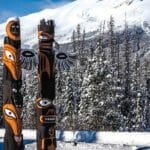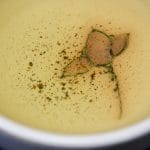Dear reader: This article contains links to products and services that I may be compensated for, at no extra cost to you.
This article was written by Sarah Hodge, prolific writer and lover of spiritual & cultural sights in Japan.
A convenient one-hour trip from Central Tokyo via the JR line, Kamakura is a history and nature lover’s paradise. Doing a Kamakura day trip is not only easy but also a great way to immerse yourself in Japan’s traditional and spiritual culture. For temple lovers, it is an essential stop on your Japan itinerary!
The seat of Japan’s first shogunate under Minamoto no Yoritomo, Kamakura was briefly the capital of Japan from 1185 – 1333 before power transferred back to Kyoto. Over the centuries, it has developed into one of the most important spiritual centers of Japan and is a pilgrimage destination. Kamakura is also a great place to take a traditional cooking course!
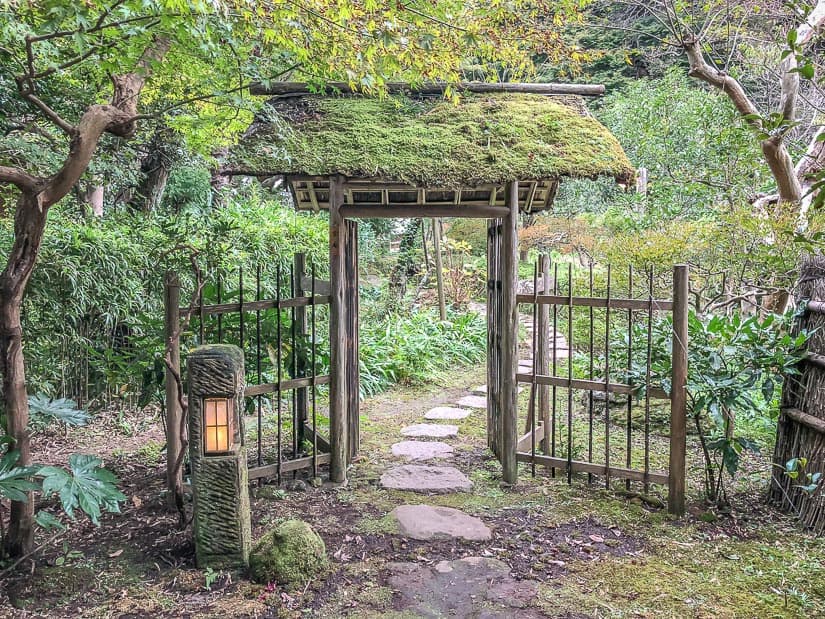
Modern Kamakura is a relaxed beach town with a laid-back vibe. Besides its dozens of Buddhist temples and Shinto shrines, you’ll find beach-themed gifts, surf shops, gelato shops and galleries lining the narrow streets in Hase en route to the Great Buddha, Kamakura’s most famous sight, and Hasedera, another important temple nearby.

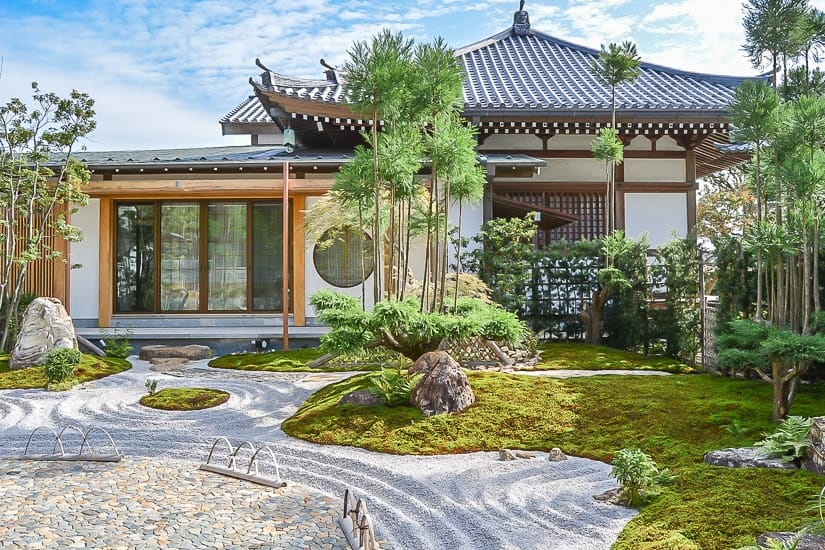
Below I’m going to share all the possibilities you could fill one day in Kamakura with, including my recommended Kamakura day trip itinerary, how to rent a yukata or kimono is kamakura, hiking in Kamakura, what to eat in Kamakura, Kamakura’s top souvenirs, how to get from Tokyo to Kamakura, and accessing Kamakura for the impaired.
Table of Contents
Kamakura Day Trip Essentials
– The best time to visit Kamakura is in spring (try March for cherry blossoms) or in autumn for beautiful foliage. If you visit Japan in winter, you may even see snow on the Great Buddha!
– Sign up for Klook with my referral link to get 350JPY off any of the Klook activities and tours I recommend below.
– If you don’t want to bother with the planning, here’s a guided full day tour of Kamakura from Tokyo on Klook, and here’s another one on GetYourGuide.
– You can rent a kimono or yukata in Tokyo before you go, for taking photos in Kamakura.
– If you’re visiting Hakone as well, you can save money with this 3-day Hakone and Kamakura transportation pass.
– Here’s a recommended Kamakura shrines and temples walking tour, or you can get escorted around in a traditional rickshaw!
Introducing Kamakura
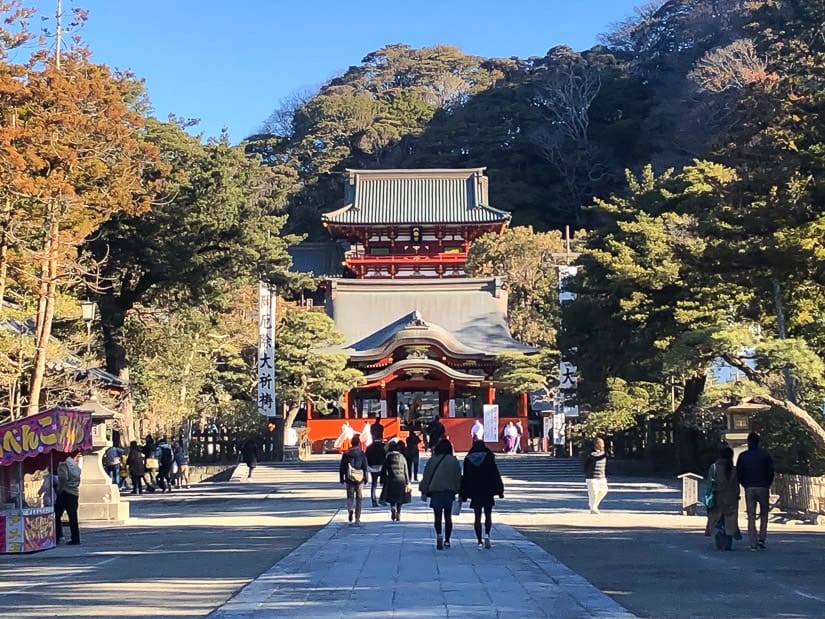
The two main attractions that most visitors come to see are Tsurugaoka Hachimangu Shrine, founded in 1180 (which features yabusame, horseback archery, in April and September) and the serene Great Buddha of Kamakura (see cover image) at Kotokuin (1252), but there are numerous smaller temples and shrines off the beaten path that also merit a visit.
Along with Kyoto, Kamakura is the heart of Rinzai Zen (there are three major Zen sects in Japan). Both Kyoto and Kamakura have temples based on “gozan,” the Chinese Five Mountain System. In Kamakura, they are Kenchoji (1253), Engakuji (1282), Jufukuji (1200), Jochiji (1281), and Jomyoji (1188).
If you are interested in participating in zazen (Zen seated meditation), Kenchoji offers guided meditation practice in English several times a year. Here is Kenchoji’s current schedule and application form.
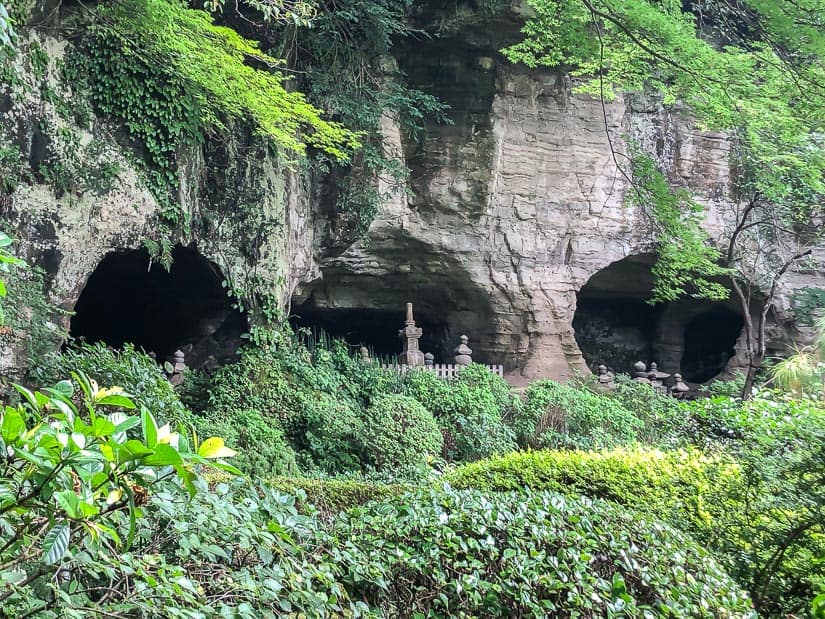
Kamakura’s temples have a unique feature known as yagura, or cave tombs, that were built by samurai and priests. The soft porous limestone is riddled with these distinctive tombs; Jochiji, Tokeiji, and Hokokuji have some excellent examples.
Another distinctive quality is the many temples with outstanding Moso bamboo groves including Hokokuji, Hasedera, and Meigetsuin.
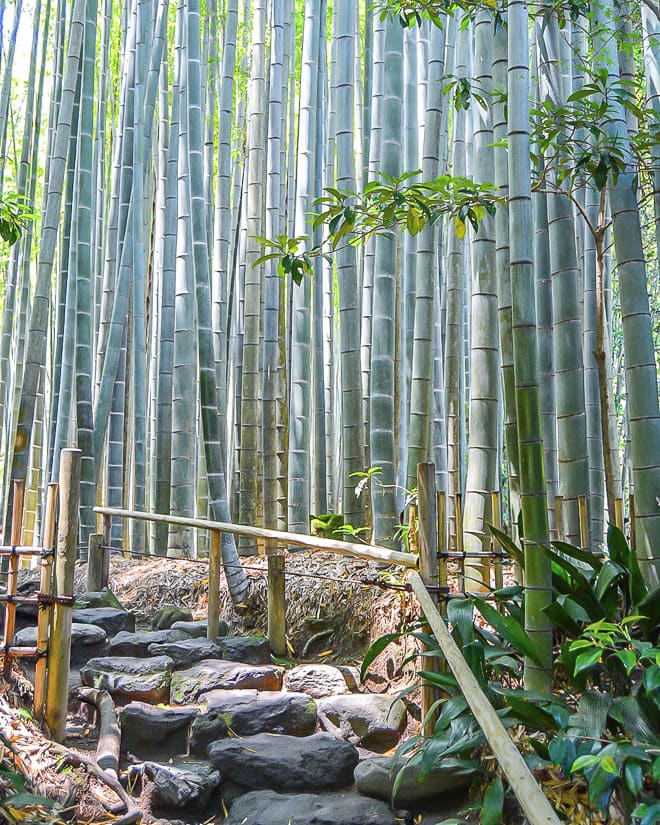
Related articles: Read about how to plan a day trip to Mt. Fuji from Tokyo, hiking the sacred Kumano Kodo pilgrimage, and visiting Kyoto in autumn.
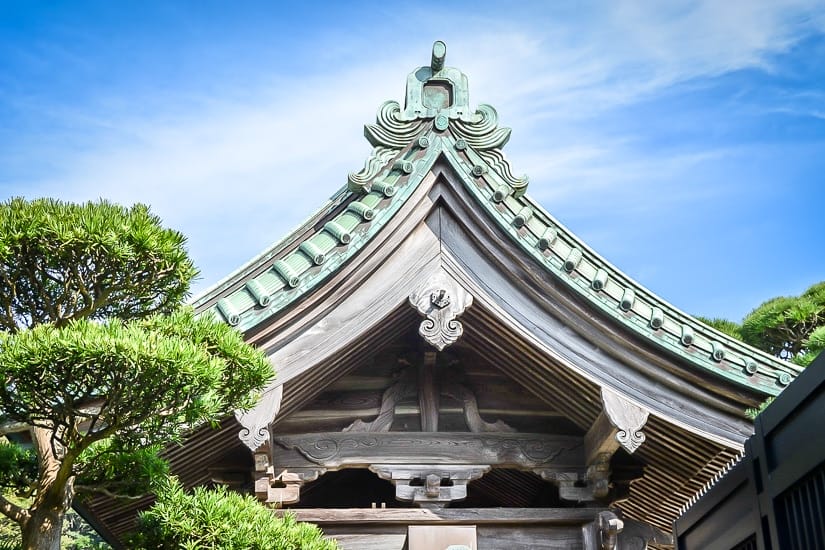
Other notable shrines in Kamakura include the Sasuke Inari (fox) shrine, Zeniarai Benten Shrine (it’s said if you wash your coins here, they will double in value!), and Kuzuhara Oka Shrine, which connects to the Daibutsu hiking trail as well as offers a stunning scenic overlook and gorgeous cherry blossoms in March.
All of these are about a 30-minute walk from Kamakura Station.
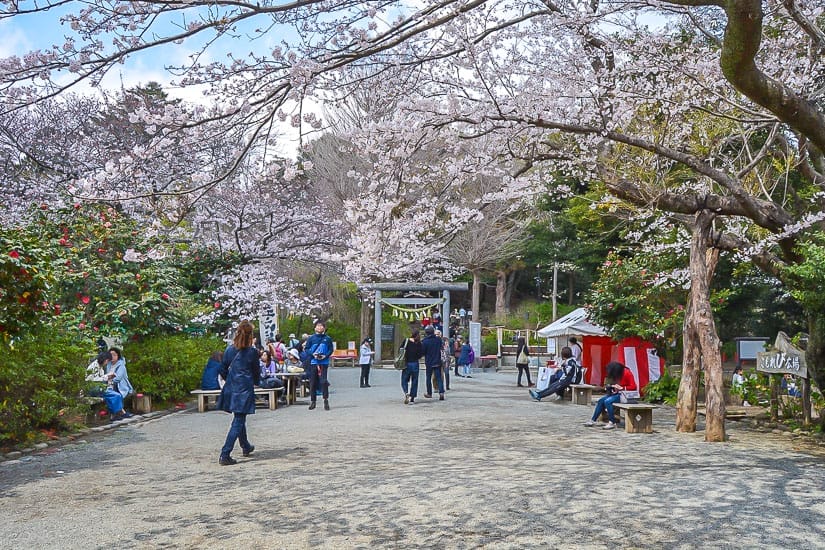
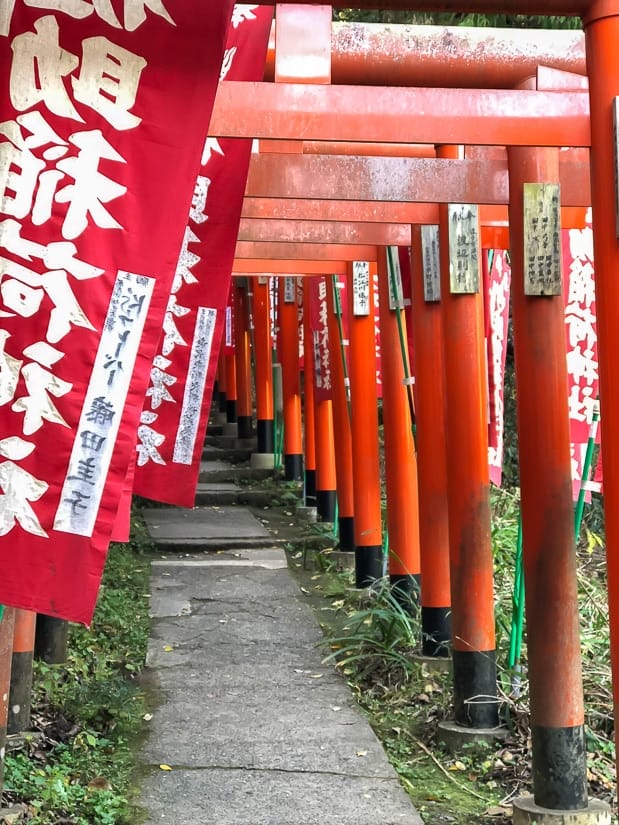
Sample Kamakura Day Trip Itinerary
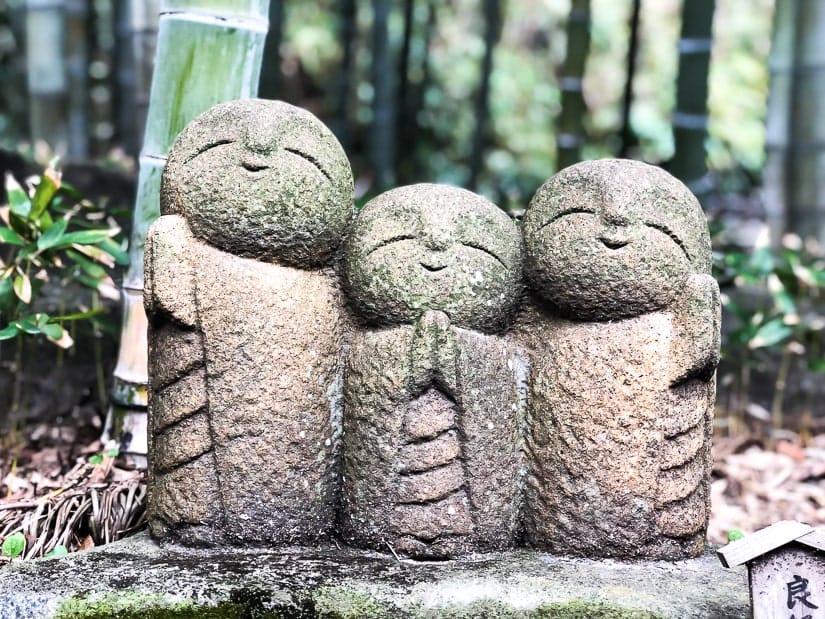
To see the best of Kamakura in one day, here’s my suggested Kamakura itinerary. Of course, you may want to modify this based on what you want to see the most!
– Disembark from Kamakura Station and walk along Komachi Street (10 minutes) to Tsurugaoka Hachimangu Shrine. Rent a kimono along the way if you’d like!
– After visiting the shrine, return to the station and catch the bus or Enoden Tram to Hase Station
– Visit the Great Buddha at Kotokuin and Hasedera Temple (5 – 10 minutes from Hase station on foot).
– If you’re looking for inner Zen, stop for a vegetarian Shojin Ryori meal at Hachinoki near Kita-Kamakura station, and visit Tokeiji temple and Jochiji temples while you’re there.
– Instagrammable highlights include the circular window at Meigetsuin (Kita-Kamakura), The Great Buddha at Kotokuin (Hase), the smiling jizo statues at Hasedera, the teahouse gate at Jochiji and the bamboo forest at Hokokuji
– Complete your day by surfing, watching the sunset on Yuigahama Beach or doing one of the hiking trails recommended below.
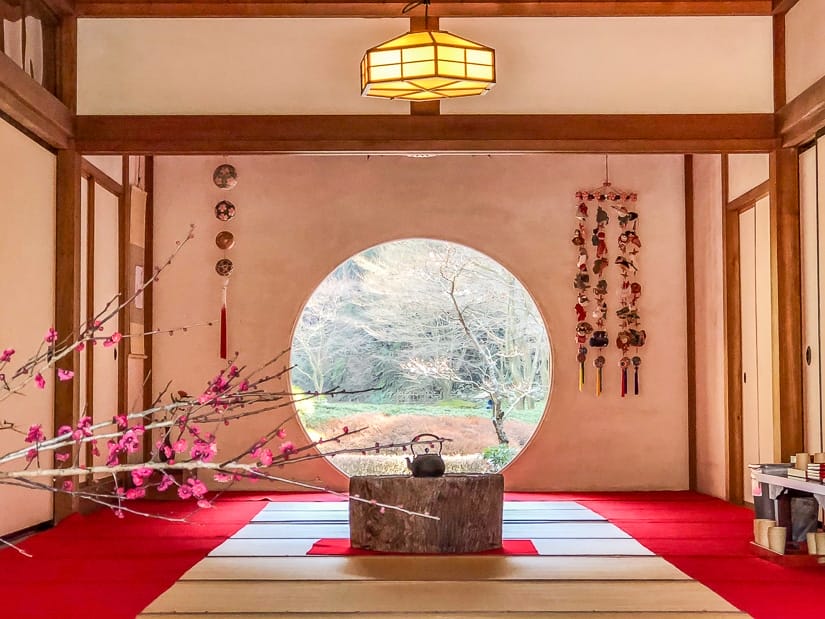
For those who enjoy a side of culture with their sightseeing, Kamakura Mind offers a wide range of hands-on craft and culture experiences in English, including guided tours, Zen meditation with the head priest of Jochiji Temple, wheel-thrown pottery, introduction to the tea ceremony, Japanese incense, indigo dyeing, Kamakura carving with a 29th generation woodcarver, cooking classes, nature walks, and other custom experiences.
How to Rent a Yukata or Kimono in Kamakura
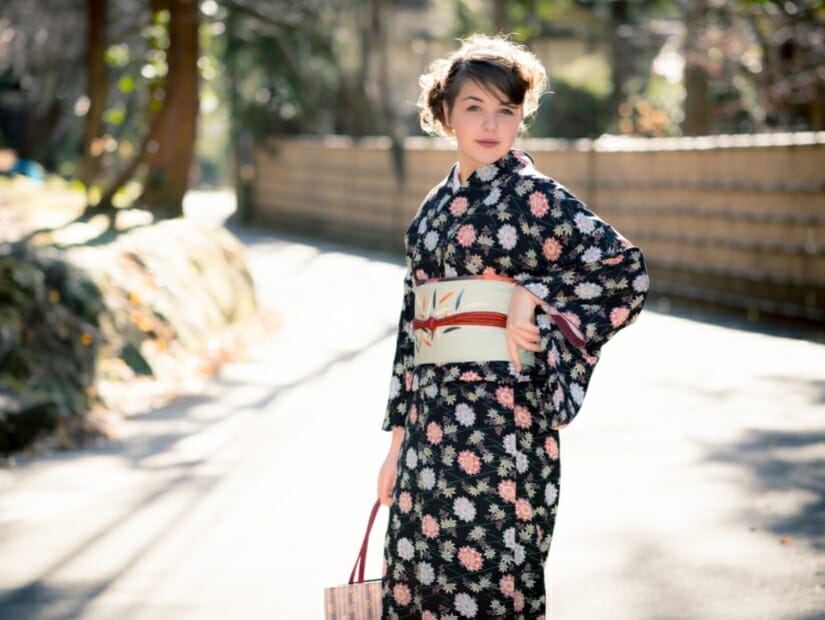
If you are interested in renting a yukata or kimono for your day trip to Kamakura, there are numerous rental shops along Komachi Street heading toward Tsurugaoka Hachimangu Shrine, such as Vasara (which has two locations). Expect to spend about 3000 – 5000 yen for a full-day rental.
You can also rent a kimono or yukata in Tokyo and bring it with you.
Hiking in Kamakura
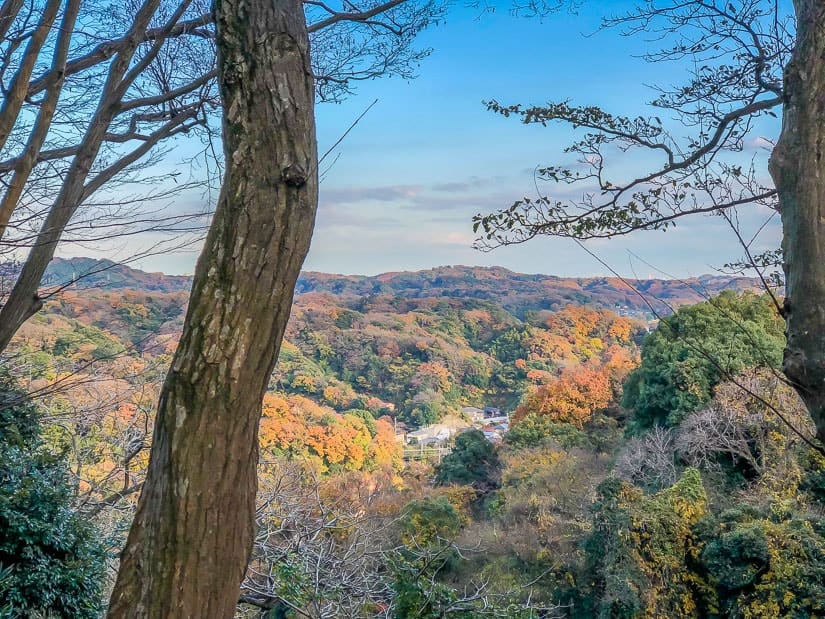
Kamakura offers several well-traveled hiking trails and nature hikes that traverse the steep hills surrounding the city (hiking poles are recommended as the terrain is very steep and uneven; probably not a good choice for those with very young children).
The Daibutsu hiking course in West Kamakura begins behind Jochiji Temple and ends at the Great Buddha (Kotokuin) and takes about 60-90 minutes to hike (oftentimes I will hike halfway to Genjiyama Park and then turn back).
The northern Tenen Hiking Course connects Kenchoji Temple in North Kamakura with Zuisenji Temple, while the Gionyama Hiking Course connects Yagumo Shrine with Harakiri Yagura, the cave tomb where the last Hojo regent Takatoki committed ritual suicide in 1333, thereby ending the Kamakura Shogunate.
Getting from Tokyo to Kamakura
Kamakura’s temples and shrines dot the rolling hills surrounding the coast (one reason Kamakura was chosen as the seat of the first shogunate was due to its natural defenses). Depending on which ones you are interested in visiting will determine how you arrive.
From Tokyo Station, take JR Yokosuka Line (918 yen, 55 minutes) or from Shinjuku Station, take Shonan Shinjuku line (920 yen, 60 minutes) toward Kamakura.
For the collection of temples including Engakuji, Meigetsuin, Tokeiji, and Kenchoji, you will want to disembark at JR Kita-Kamakura station (North Kamakura) one stop before Kamakura Station. For all other sights, continue on to Kamakura station.
Assuming you are arriving from Tokyo, Yokohama or points north, your train will arrive on Platform 1 of Kamakura Station (if you are coming from Yokosuka or points south, you will arrive on Platform 2).
You can also travel from Tokyo to Kamakura by private transfer.

Getting to Tsurugaoka Hachimangu Shrine
Descend the stairs and follow signs for East Exit.
As you exit Kamakura Station via the East Exit, you will find coin lockers and public restrooms immediately to your right next to the Koban (police box).
The Kamakura Tourism Information Office is directly to the left next to the ticket machines; they open at 9:00 and are a great resource for maps, guidebooks and information in English, Chinese, Korean and other languages.
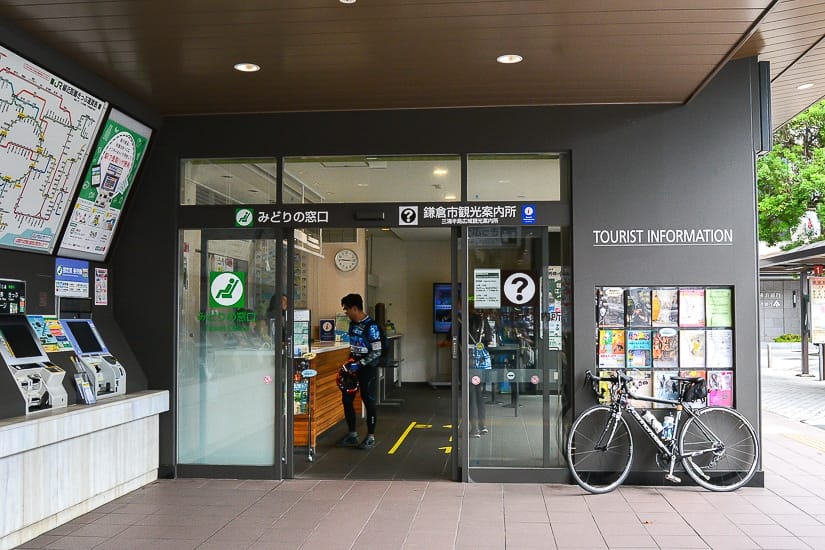
If you need cash, the Bank of Yokohama to the left of the TI has an International ATM (use machine number one at the very back); be aware that most Japanese ATMs do NOT accept international credit or debit cards issued outside of Japan. The general exception to this is Japan Post and 7-11 ATMs, so this is a convenient time to get cash if necessary
To go to Tsurugaoka Hachimangu Shrine, turn left (you can either stroll down Komachi-dori, a popular shopping / souvenir street, or continue for one block straight and then turn left onto the main road facing Hachimangu (less crowded, more upscale shops and restaurants).
Getting to Hokokuji (bamboo grove)
To reach Hokokuji, take bus 23, 24, or 36 from Kamakura Station bus stand 5 to Jomyoji Temple stop (10 minutes from Kamakura Station, 220 yen one-way, it’s about a 5-min walk to Hokokuji).

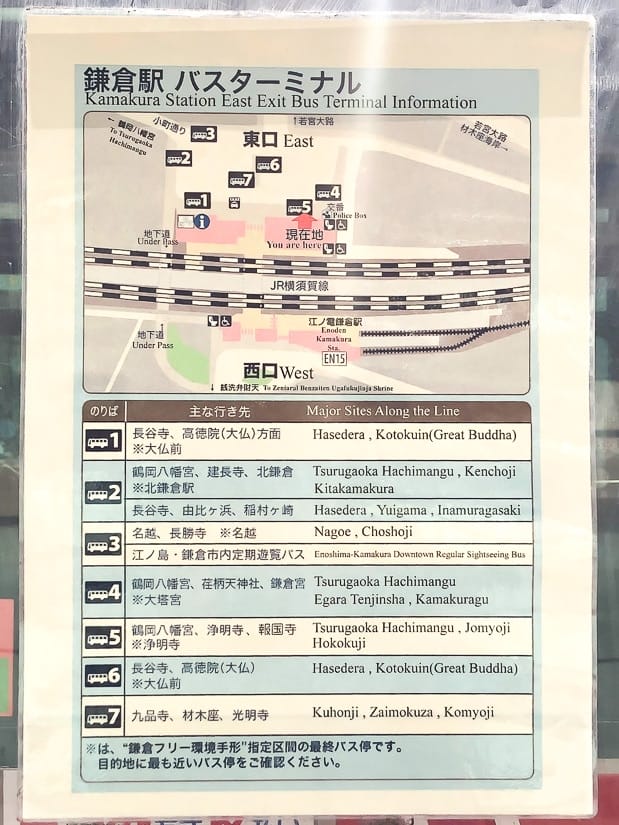
Getting to Hase (for Great Buddha and Hasedera)
Hasedera and the Great Buddha (Kotokuin) can be reached by either transferring to the Enoden Tram and taking it for three stops to Hase (EN-11), or by catching a bus from Kamakura Station (see below). (Use photos: Meigestuin, Hasedera, Engakuji)
For the Enoden Tram, head down the stairs, turn left and follow signs for West Exit, walk through the tunnel and follow the signs for “Enoden.”
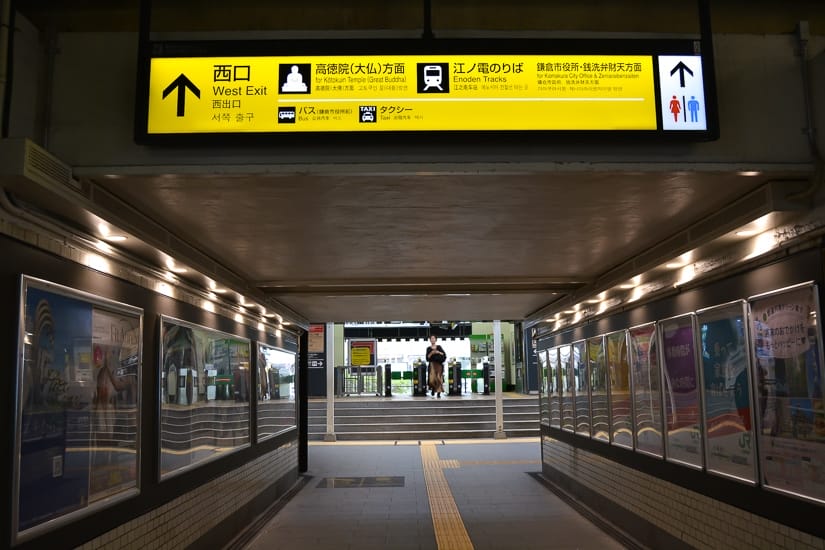
STOP. Don’t go through this exit gate; turn left where the steps are and look for the “Enoden Gates” sign. (There are restrooms here to your right and also another set of restrooms beyond the Enoden gates if the lines are long). If you are using a PASMO or Suica card, touch your card to the reader and proceed through the gates, or purchase a ticket from the ticket machines outside the gates.
Go through the gates and proceed straight ahead to the tracks. (There is only one boarding platform; the Enoden line opened in 1902 and is a single track between Kamakura and Fujisawa).
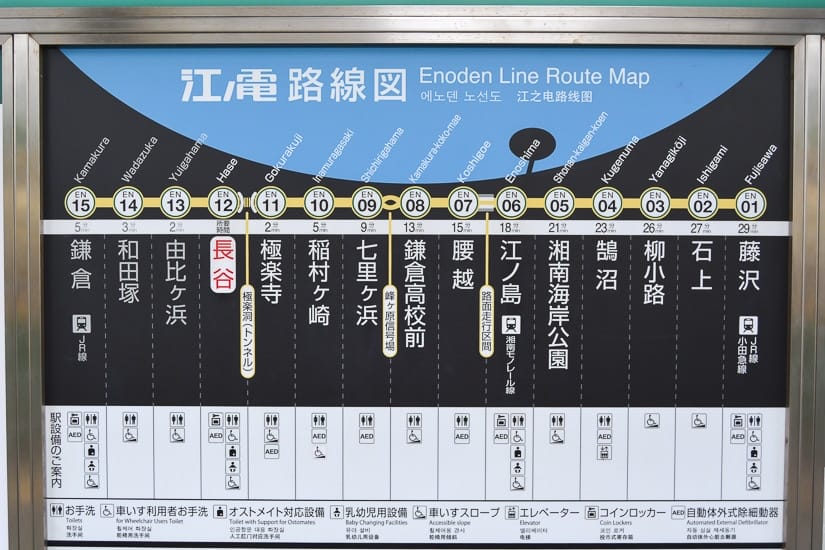
To reach Hase, take the Enoden for three stops to EN-11, Hase.
As you exit the platform, you will have to wait for the tram to exit the station and clear the tracks before you can cross to the exit gates.
After exiting the gates, turn right and follow the sidewalk straight for about a 5-minute walk (to Hasedera) or a 10-minute walk (to Kotokuin). Note the sidewalks are VERY narrow and very crowded on weekends. When you return to the station, it can be a bit hard to spot the entrance as the outside is currently covered for renovation; look for the green-and-white stripes in front of the tracks on the left-hand side right before the traffic light. (Use photo: Hase Station Left Side)
Where to eat in Kamakura
There are a large number of restaurants lining Komachi Street and on the road to Tsurugaoka Hachimangu shrine, including international (Turkish, French, Italian), Japanese, hamburgers (my colleagues have said great things about Rooftoops Café and Diner), and even craft beer at Rudy Brew.
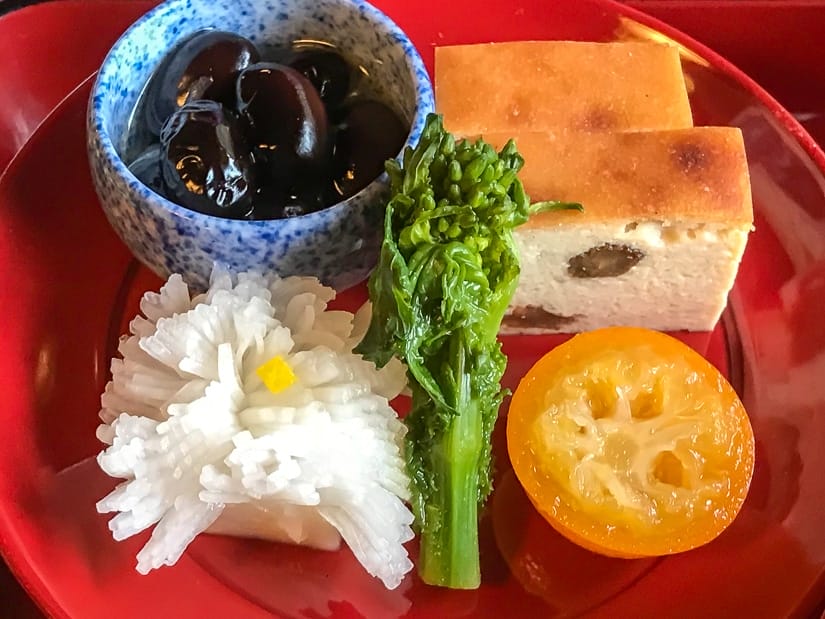
As a center of Rinzai Zen, Kamakura also has a long history of shojin ryori, vegan temple cuisine (one of the better-known dishes, Kenchin Jiru, is actually named for Kenchoji Temple where it is said to have originated).
You can sample shojin ryori at the exquisite Hachinoki in Kita-Kamakura (it is conveniently located to Kita-Kamakura station as well as across from lovely Tokeiji, the only surviving nunnery of the Amagozan system in Kamakura).
Another great place to try shojin ryori in Japan is at the sacred hilltop village of Koyasan. Read about how to do a temple stay in Koyasan, including enjoying the best shojin ryori.
You can also take hands-on shojin ryori classes from Mari Fujii, author of The Enlightened Kitchen and sisters Akemi and Satsuki, who have written several cookbooks on shojin ryori and have been featured on NHK, at Atelier Café Kamakura.
Kamakura also has some excellent artisanal gelato shops; highly recommended are Collina Kamakura Gelato and Kamakura Gelato. If you are in need of a coffee fix, there’s a local branch of Nagoya-based Kannon Coffee right next to Hasedera, which has adorable Great Buddha-shaped cookies and homemade baked goods.

Another great choice is Santa Cruz-based Verve Coffee next to Tsurugaoka Hachimangu Shrine, with a sleek, spacious interior, plenty of seating and super-friendly baristas (I highly recommend the orange-infused Latte Valencia).
One more interesting food experience you can enjoy in Kamakura is learning how to make your own bento box.
Important note: Kamakura has issued a city ordinance against eating and walking; if you purchase food from street vendors, particularly along Komachi Dori, it’s better to consume the food at the stall and dispose of your trash there. There are no fines or citations for violating the request, but a little courtesy goes a long way.
Best Souvenirs in Kamakura
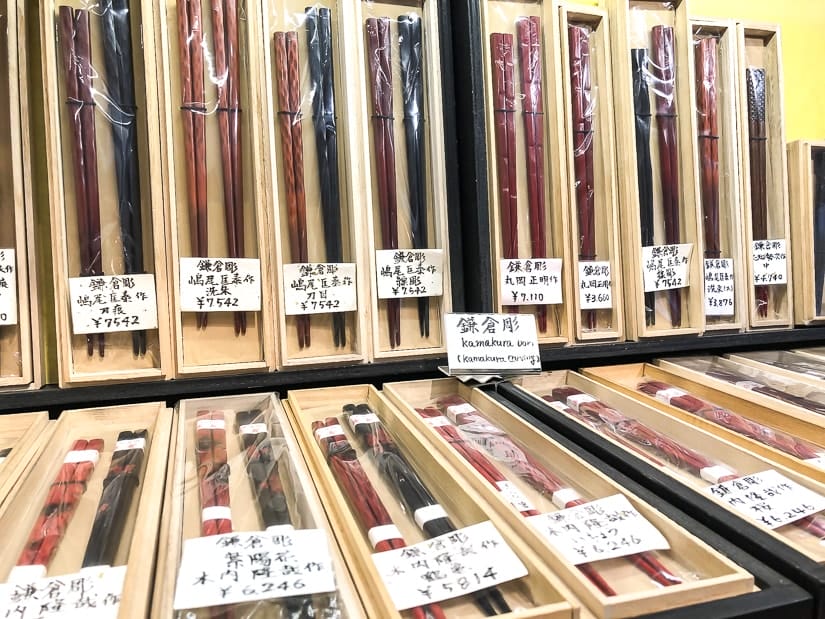
Hands-down the most famous souvenir associated with Kamakura is Hato Sable, dove-shaped butter cookies reminiscent of the white doves at Tsurugaoka Hachimangu Shrine.
The flagship shop is in a cavernous white building on the left-hand side as you are walking towards Tsurukagoka Hachimangu Shrine. My personal favorites are the delicious walnut and caramel Kurumikko shortbreads at Kamakura Beniya, available at several locations around town.
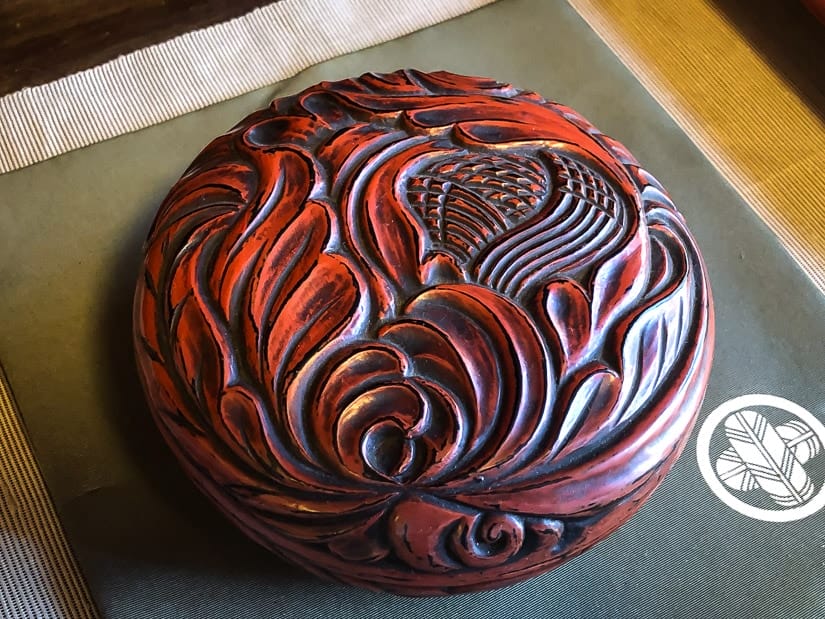
The most interesting local craft is Kamakurabori, distinctive carved and lacquered items made from katsura wood. There are a number of shops and galleries where you can find pieces ranging from affordable to exquisite; Kamakurabori chopsticks and chopstick rests are a good option.
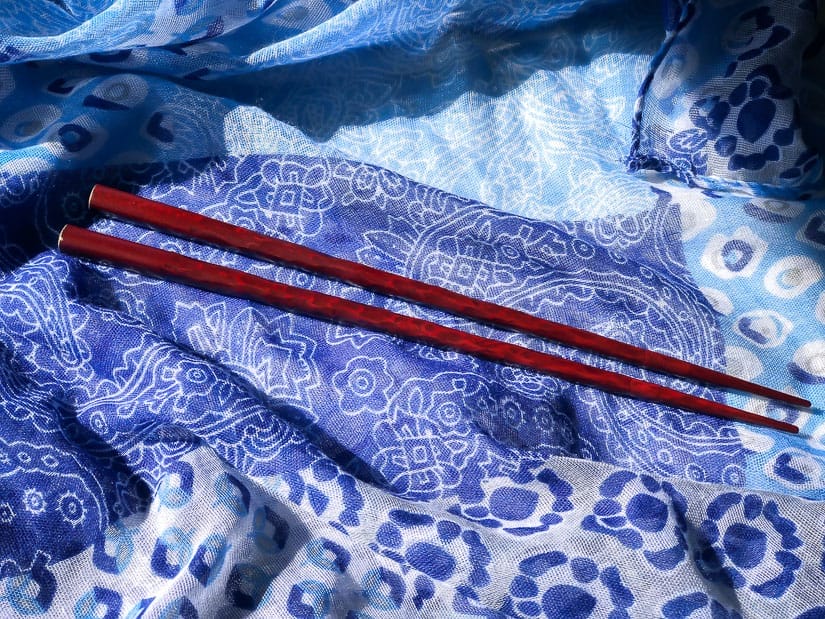
The Hakkodo gallery run by the Goto family (one of the last remaining Kamakurabori families in Kamakura) is located across from the entrance to Hachimangu Shrine. You can also sign up for a hands-on class carving your own Kamakurabori chopsticks with Kyukei Goto-san (a 29th-generation master carver) through Kamakura Mind.
It is even possible to see Mt. Fuji from the western side of Kamakura. See here for all the best spots to see Mount Fuji.
Kamakura Accessibility Info
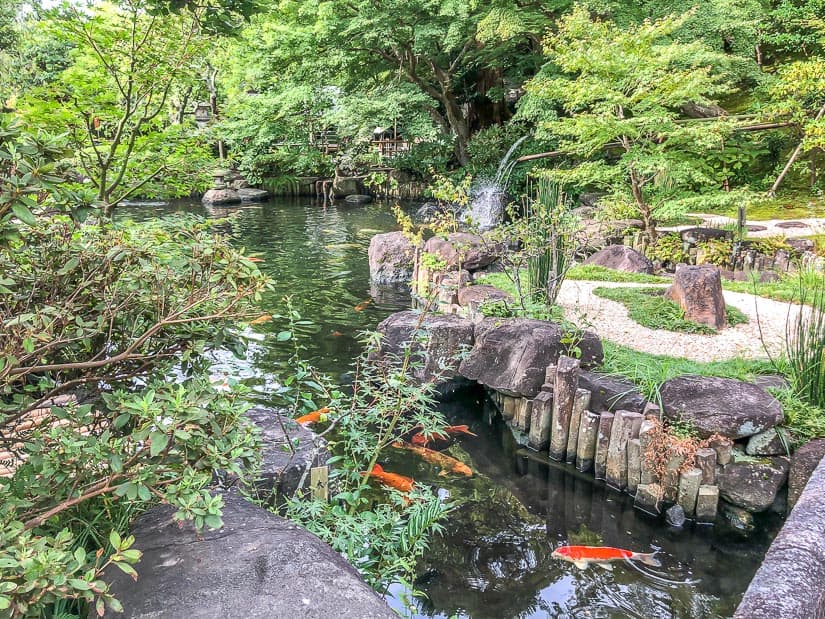
Japanese train stations have multiple features for the visually impaired, such as tactile pavement (for easy navigation using a cane), handrails have information in Japanese braille, talking ticket machines, and some stations / bathrooms have an audio guide or Braille layout map (in Japanese).
JR trains offer at least one wheelchair-accessible bathroom on board (when the station attendant helps you board, it will likely be the same car with the accessible bathroom).
Kamakura Station is fully wheelchair accessible and includes multipurpose bathrooms.
At Hase Enoden Station, there is NO elevator / ramp; if you use a wheelchair, please inform station staff at Kamakura Enoden Station before boarding and they will arrange for a temporary ramp at Hase station so you can disembark. Note that sidewalks are VERY narrow and crowded in Hase along the main street and may be a tight squeeze for wider electric wheelchairs.
Kotoku-in Temple in Hase is fully wheelchair-accessible with ramps and restrooms. At Hasedera, only the lower level / garden is accessible by wheelchair as the main temple requires climbing several sets of stairs, but the gardens are very pleasant (there are newer, very spacious multipurpose toilets located next to the parking lot at Hasedera). Most temples / attractions offer free admission with a disability card. (Use photos: accessible Hasedera)
It is possible to book a one-day guided barrier-free tour of Kamakura and Enoshima departing from / returning to Tokyo; see more information here.
Read about the Kumano Sanzan, three very beautiful and important Shinto-Buddhist shrines on the Kumano Kodo pilgrimage.
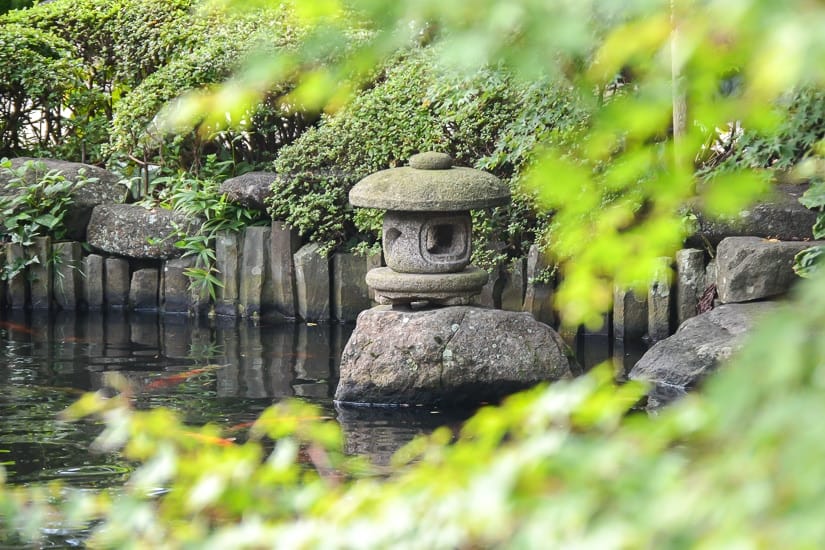
About the Author
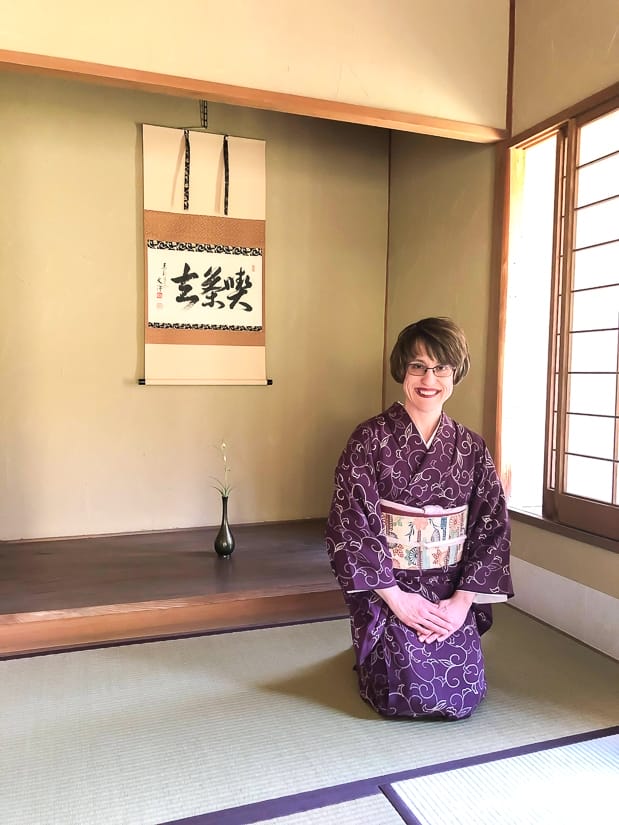
Sarah Hodge is a freelance travel and culture writer for Tokyo Weekender magazine and Stars and Stripes Japan newspaper and has traveled extensively around Japan.
A frequent visitor to Kamakura, her areas of interest include Japanese cuisine, kimono, Zen Buddhism, Japanese gardens and pilgrimages (she has visited Koyasan, Kumano Kodo, and hopes to walk part of the Shikoku 88-Temple Pilgrimage next year).

